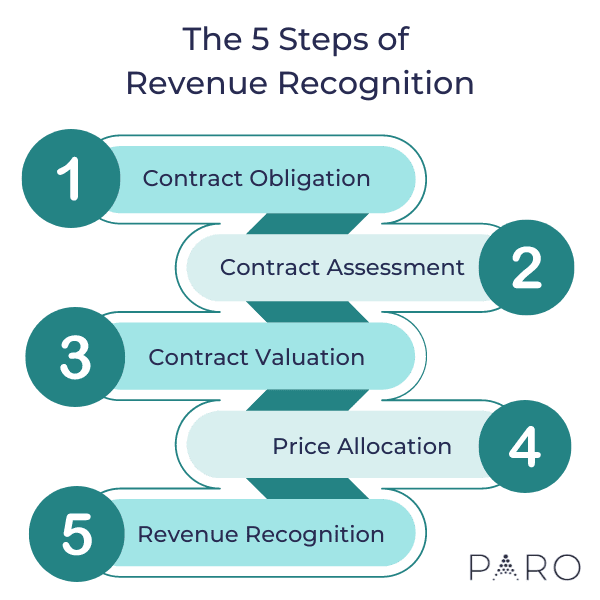Growth can be a double-edged sword of surging revenues and, unfortunately, surging regulatory requirements. If revenue is steadily rising beyond what cash accounting can handle, or you suddenly need to supply GAAP-compliant financials to lenders and investors, then ASC 606 revenue recognition standards will become a priority for your accounting function. The revenue recognition principle comes with its own complexities on a transactional level, but your accounting function’s infrastructure—from people to technology—will also play a part in making a smooth transition. Here’s what to expect.
What Is the Revenue Recognition Principle?
Revenue recognition describes how and when a business records its revenue transactions. Simple business structures for sole proprietors and early-stage businesses usually operate on a cash basis. This means that income is recognized when payments are received for goods and services sold. That process is easy to understand and implement, but it usually doesn’t adequately represent an organization’s financial position.
When customers pay in advance of receiving goods or services, their customers have exchanged their capital for a future benefit. Similarly, when items are bought on credit, customers receive the benefit of the goods and services before you receive payment. Recording the transactions on an accrual basis—as the revenue is earned— provides improved transparency and insights to all parties.
What Is ASC 606 and Why Was It Established?
A prominent tenet of Generally Accepted Accounting Principles (GAAP) is the matching principle. It states that revenue needs to be recorded in the same period as its corresponding expense. In order for this to occur, organizations must follow GAAP and use an accrual-based accounting method. In 2014, the Financial Accounting Standards Board (FASB) and the International Accounting Standards Board (IASB) collaborated to issue Accounting Standards Codification (ASC) for Revenue Recognition ASC 606 and International Financial Reporting Standards (IFRS)15 Revenue from Contracts with Customers. ASC 606 compliance and accompanying global standards enhance comparability and simplify the hundreds of industry-specific guidelines into an agnostic, five-step framework.
Pro tip: If your organization isn’t following GAAP yet, it’s important to stay abreast of the IRS receipts requirement threshold. Recently adjusted for inflation, the IRS allows small businesses with average annual gross receipts of $27 million or less over the prior three tax years to choose their accounting method. Once the threshold is reached, businesses must adhere to GAAP and its accrual accounting requirement. This can create a tax liability before a client’s payment is received.
What Are the 5 Steps of Revenue Recognition?
Prior to the adoption of ASC 606, there were hundreds of revenue recognition guidelines that addressed industry-specific practices. Using today’s standard, there’s now have a 5-step framework that walks you through the thought process of examining contracts and individual transactions in a more unified approach.
Though this framework simplifies the process, it’s still a good practice to work with a professional controller to ensure you’re correctly interpreting your contracts for your specific business model.

- Contract obligation: Identify the contract with a customer. Contractual obligations extend beyond the written word. A verbal agreement to exchange an item or service for consideration—either a financial or non-financial value—are equally as important as formal contracts or terms of sale.
- Contract assessment: Identify the performance obligations in the contract. Every agreement includes contract terms that define the offer and acceptance. The duration of the contract, quantity and timing of the items exchanged, and the legal capacity for entering into the contract, may be explicit or implicit in the agreement.
- Contract valuation: Determine the transaction price. Contracts often consist of multiple exchanges or potential exchanges. Each separately identifiable obligation must be clear to ensure its performance and completion are mutually agreed upon. Included are situations where multiple actions are required to create a completed project or where there’s opportunity for the customer to return the goods or receive credit for unsatisfactory services.
- Define the allocation: Allocate the transaction price. The total value must be split among each distinct obligation to ensure that revenue for each transaction element totals the full value of the revenue earned. The method of allocation can be a percentage of completion, time having passed or by any other reasonable method.
- Record the activity: Recognize revenue when or as the entity satisfies a performance obligation. Each transaction within a contract must be recorded within the appropriate period when it’s earned. Payment for the transaction is not an indicator of when recording the revenue recognition activity occurs.
But this is just the framework for recognizing revenue. ASC 606 compliance requires more work under the surface to effectively follow the revenue recognition principle and transition your team to a new method.
The Nuances of ASC 606 Revenue Recognition Standards
The revenue recognition principle requires industry-specific challenges be resolved in similar ways to ensure the comparability of their financial reports. But the differences among industries and how they recognize revenue creates nuances, so it’s important to be aware of various types of transactions and any supplemental guidance that has been issued. For example:
- How should a SaaS company apply upgrades, downgrades, promotions and cancellations?
- Is eCommerce revenue recognized at shipment or upon delivery?
- Should a product warranty be recorded as a distinct transaction or bundled with the sale of the retail product it covers?
- Are revenues for cooking classes recorded on a prepaid meter basis or tracked and recorded as they are used?
- Would digital goods revenues be booked upon purchase when the download is made available or when a download actually takes place?
ASC 606 compliance requires exercising a great deal of judgment. The fact patterns and consistency with which it’s used is critical when financial statements are reviewed by auditors and other external parties.
- As the seller, are you operating as a principal or as an agent? The former typically records gross revenue while the latter records net revenue.
- Does the existence of a financing component change the timing or accounts used to record revenue?
- If an IRS amortization schedule is used, does it correlate with the period of benefit or is a separate schedule required for revenue recognition?
- Are renewals recorded differently if they are automatic and assumed versus if they are recorded manually as the new contract term is agreed upon?
Does Your Team Have What It Needs to Streamline Compliance?
ASC 606 compliance doesn’t just impact the way that your team interprets contracts or records revenue. This standard also changes the way that you collect and report data. Other areas of your accounting function must be prepared accordingly.
A fractional controller can help you prime your team for success by working through the following questions and providing solutions to each::
- Data collection & analysis: Is the data surrounding pricing, performance obligations and contracts accurate?
- Transition & comparative reporting: How will you adjust previous financial statements and compare financial reports meaningfully?
- Systems integrations: Do you have seamless data integration between finance, sales and other relevant departments to appropriately recognize revenue?
- Education & training: Is there someone to provide guidance to all relevant departments in the new revenue recognition standard?
- Documentation & controls: Are there standard operating procedures in place to maintain consistency, prevent errors or streamline the process?
Where Do You Stand with Revenue Recognition?
The ASC 606 revenue recognition standard is nearly a decade old, but it may be new to your growing business. The excitement of a merger or acquisition or expanding product lines is often tempered with apprehension for those that need to adapt to new regulations and requirements. Enlisting the aid of a seasoned professional is an excellent way to retain your excitement while meeting your company’s business obligations.
At Paro, we match you with vetted industry professionals who can review your revenue recognition practices and advise or help you implement needed changes. Our fractional controllers have years of experience in accounting compliance and oversight, so your business can make the transition smoothly and keep momentum going.












